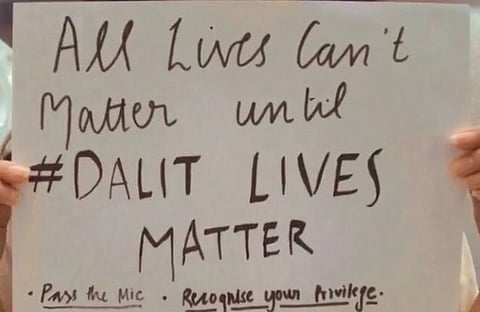
New Delhi - The presence of power dynamics between the ‘non-scheduled communities’ and ‘scheduled communities’ has existed for a long time. Unfortunately, many Dalit and Adivasi lives have been treated as unequal in India. The Scheduled Castes and Scheduled Tribes (Prevention of Atrocities) Act, 1989, emerged to put an end to societal injustice. But the current trends show that this is far from over. Scheduled communities still face violence at the hands of their oppressors, who are mainly from the unreserved class. Data paints the correct picture.
The Citizen’s Vigilance and Monitoring Committee came up with a report that reveals the grim reality of the society. The first-ever 'Citizen's Audit of the Union Report under Section 21(4) of The Scheduled Castes and Scheduled Tribes (Prevention of Atrocities) Act, 1989,' exposes the distressing experiences members of various Scheduled communities across the nation face.
The report puts everyone’s doubts to rest. It exposes the fact that the crimes against Dalits and Adivasis in our country are on the rise, more so since 2016. There is a need to take this into consideration immediately and discuss various actions that could be undertaken to bring the numbers down.
According to the report, in 2021, fifty-nine thousand crimes were recorded against people from the scheduled castes. In 2016, the number was forty thousand, eight hundred and one, an increase of almost ten thousand crimes in a period of 6 years. Crimes against people from the Scheduled Tribes rose from six thousand, five hundred and sixty-eight in 2016 to eight thousand, eight hundred and two in 2021.
The recorded crime rate against scheduled communities rose from 20.3 in 2016 to 25.3 in 2021 for Dalits and from 6.3 in 2016 to 8.4 in 2021 for Adivasis. The report states that this data has been cited from the ‘Crime in India’ document of the National Crime Records Bureau. “The citizen’s report uses the number of cases where the Scheduled Castes and the Scheduled Tribes (Prevention of Atrocities) Act, 1989, are invoked (some of which do not invoke sections of the Indian Penal Code). The union report uses the number of cases where the Scheduled Castes and Scheduled Tribes (Prevention of Atrocities) Act, 1989, is invoked in conjunction with IPC, which is a subset of the former,” reads the audit.
Uttar Pradesh and Madhya Pradesh record the greatest number of atrocities against Dalits and Adivasis, respectively:
The year 2021 marks the third consecutive year in which over a thousand from the scheduled communities were murdered in inter-community crime, i.e., by persons from non-scheduled communities. Just 15 states record over 98% of the crimes recorded under the atrocities act. The states where most of the atrocities against the scheduled castes take place, in descending order, are Uttar Pradesh, Madhya Pradesh, Rajasthan, Bihar, and Maharashtra. Most recorded atrocities against scheduled tribes, in descending order, happen in Madhya Pradesh, Rajasthan, Odisha, Maharashtra, and Telangana.
Here, talking about the severity of the crimes also becomes important. One logic is that there should be an inverse relation between the frequency and severity of atrocities. For example, for non-scheduled communities, there are 1.85 attempts to commit murder for one murder, 1.7 grievous hurt for one attempt to commit murder, and 5 simple injuries for every grave injury. But during inter-community violence, the number seems to change rapidly.
For Scheduled Castes, “about one (0.97) attempt to commit murder is registered for one murder, 1.6 grievous hurt for every attempt to commit murder, but over 11 simple injuries for one grave injury.” This shows that a lot of Dalits would go to the police in case of simple injuries but not for a severe crime.
For Scheduled Tribes, it is worse. “0.8 attempts to commit murder are recorded for one murder, one grievous hurt for every attempt to commit murder but over 14 simple injuries for one grave injury.” This figure might even suggest that Adivasis generally succumb to attempts or grave injuries before even reaching the police, or they do not report the crime. A higher rate of simple injuries might suggest that otherwise, the community would reach out to the police even in cases of simple injuries if they are allowed to do so.
The report also says, “compared to the national mean of recorded inter-community murder to an attempt to commit murder, recording is only 53% for the scheduled castes and 45% for the scheduled tribes. For the STs, there is over a 41% gap between the recorded grievous hurt to an attempt to commit murder and the rate of those recorded overall, while for the scheduled castes, it is just a 5% gap indicating little divergence from the overall national recording trend.”
This act is a key legislation in a diverse nation like ours to prevent atrocities against the scheduled communities. The implementation of the atrocities act is supposed to be reviewed quarterly by the sub-divisional, district, and state-level vigilance and monitoring committees, chaired by the sub-divisional magistrate, district magistrate, and nodal officers, respectively. In addition, there is a state-level high-power vigilance and monitoring committee that reviews implementation in January and July every year.
Also Read-
You can also join our WhatsApp group to get premium and selected news of The Mooknayak on WhatsApp. Click here to join the WhatsApp group.